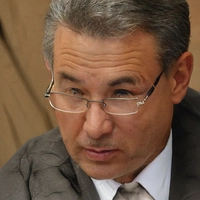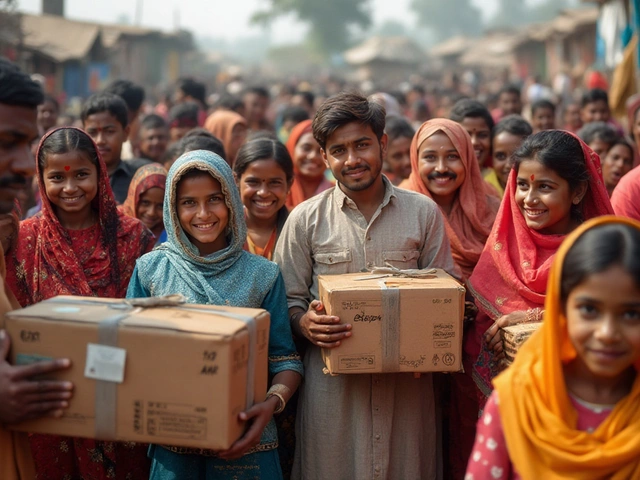Charitable giving is a fascinating phenomenon, with its roots deeply entwined in our cultural and social fabrics. When we think about generosity, a question often arises—who really gives more to charity: the rich or the poor? This topic stirs curiosity and debate across communities and circles, from economic experts to everyday individuals pondering the nature of giving.
Exploring this question requires peeling back layers of data and stories, painting a picture that's as nuanced as the people who give. Income, philanthropy trends, and the motivations driving individuals to donate their time or resources all play pivotal roles. It's not simply about numbers or the size of one's wallet; there's an intricate web of reasons that guide the decision to help others.
Join us as we uncover the behaviors and inspirations that fuel charitable donations, looking closely at who is making a difference and how. Whether large or small, each contribution tells a unique story of compassion and connection.
- Income Bracket Giving Patterns
- Motivations for Charity
- The Impact of Donations
- Surprising Generosity Stories
- Encouraging Philanthropy Across All Levels
Income Bracket Giving Patterns
The discussion about who gives more to charity—the wealthy or the poor—has long been a subject of intrigue. We dive into data and stories to dissect these philanthropy patterns. Studies from sources like the National Philanthropic Trust indicate that people across different income levels engage with donations in unique ways. One interesting finding is that, proportionally, lower-income households tend to give a higher percentage of their income to charity compared to their affluent counterparts. Often driven by immediate community needs, these households prioritize social bonds and mutual aid over accumulating wealth.
On the other hand, the wealthy make headlines for their large endowments and philanthropic foundations. These significant financial contributions often make a deep impact, shaping entire sectors like healthcare, education, or arts. Known philanthropists like Bill Gates and Warren Buffett have set the stage with initiatives like The Giving Pledge, encouraging billionaires to allocate a majority of their wealth to charitable causes. Their actions underline a strategic approach: addressing long-term, systemic issues rather than immediate, localized concerns. While some critics argue that these contributions, albeit generous, might come with strings attached or serve to enhance one's social status, it remains undeniable that the wealthy do play a vital role in funding large-scale projects.
Are perceptions of charity in different income brackets accurate, though? An interesting anecdote from journalist Paul Piff suggests that while wealthier individuals can afford to give in large sums, there are societal expectations that play a role in philanthropic efforts.
Piff mentions, "While the rich might give more dollars, it’s the poor who give more compassion, more time, and more directly to individuals in need."For middle-income earners sitting between these extremes, the patterns differ; their giving tends to be influenced by personal values, social norms, and sometimes even tax incentives. They often engage in donations that balance between their aspiration for change and the limitations imposed by their financial bandwidth.
Surprisingly, younger generations like millennials and Gen Z are redefining these patterns through crowdfunding platforms and social media. They leverage technology to facilitate small, frequent contributions—thereby increasing participation and impact. Many in these generations show interest in transparency and accountability, choosing organizations where they can see tangible outcomes of their contributions. This shift points towards a promising future where every contribution, irrespective of size, has its place and influence in the broader philanthropic spectrum.
While navigating this landscape of giving, it is essential to recognize how economic disparities influence charity perceptions and practices. Whether you’re an affluent individual considering a grand gesture or a person contributing modestly, every act of philanthropy is part of a larger, interconnected network of goodwill—a network where every donation, regardless of its proportion, contributes to shaping a more compassionate world.
Motivations for Charity
When delving into the motivations behind charitable giving, it's crucial to acknowledge the complexity and variety of reasons people choose to open their wallets. In many cases, personal experiences with hardship inspire individuals to give back, often motivating those with less to contribute a portion of their limited resources. This notion of empathy-driven generosity is reflected in numerous studies, which suggest that people who have faced their own struggles are more inclined to feel compassion for others.
Another powerful driver for charity is the desire to leave a legacy or make a meaningful impact on the world. This is especially prevalent among the wealthy, who have the means to support large-scale initiatives and long-term projects. In fact, philanthropic contributions from the wealthy have been pivotal in funding research, building hospitals, and supporting educational institutions, demonstrating their impact on society. Charitable acts, in this regard, often act as a bridge to a more lasting form of social change, which aligns with many people's desire to be remembered for something significant.
Tax incentives can also play a significant role in motivating donations. Governments worldwide often provide tax breaks as a reward for generosity. This strategy serves as an effective tool to encourage financial contributions, especially from those who can afford to give larger sums. Yet, the question remains whether individuals donate mainly for the tax benefits or if these are merely a coincidental perk. In either case, the intertwining of fiscal benefits with acts of philanthropy adds another layer of complexity to the motivations behind giving.
"The real measure of our wealth is how much we'd be worth if we lost all our money," remarked famed investor Warren Buffett, highlighting the intrinsic values that often accompany philanthropic endeavors.
Cultural and familial influences also significantly shape the motivations for charitable giving. In many societies, there is an inherent expectation or tradition of giving back to the community, whether through family teachings, religious practices, or societal norms. These cultural imperatives ensure that the act of giving is not only a personal decision but a collective expectation, fostering a culture of generosity that spans across economic classes. Interestingly, communities with strong religious or cultural giving traditions report higher rates of donations, underscoring the importance of these factors in motivating individuals to give.
The emotional benefits of giving should not be underestimated. There is a widely documented 'helper's high', a term used to describe the emotional satisfaction derived from assisting others. This psychological lift can reinforce charitable behaviors, creating a positive feedback loop where the giver continues to contribute because it simply feels good. This connection between altruism and happiness is a significant motivator and provides insight into why some people become lifelong philanthropists, continually seeking out new ways to make a difference.

The Impact of Donations
Understanding the impact of donations requires more than just looking at financial statements or annual reports; it involves seeing the real-world changes that charitable acts bring about. Every contribution, whether from a billionaire's foundation or a generous middle-income family, plays a pivotal role in transforming communities and individuals' lives. For instance, donations fund essential services such as emergency relief efforts, educational programs, and medical research. These are not abstract concepts; they translate into food on a struggling family's table, a scholarship enabling a deserving student to attend college, or a breakthrough in treating life-threatening illnesses.
Charities often serve as the bridge between those with the means to give and those in dire need. This connection not only addresses immediate needs but also facilitates long-term societal change. A donation might fund a vocational training program in an underserved area, which in turn helps community members gain employable skills, breaking the cycle of poverty. Additionally, foundations like the Bill and Melinda Gates Foundation have mobilized resources globally to combat preventable diseases and promote health in developing countries, showcasing the broad reach of philanthropy.
Individual donations, surprisingly, often come from those who themselves have limited resources. According to research, people with lower incomes tend to donate a greater percentage of their earnings than their wealthier counterparts. This might seem counterintuitive, but it highlights a profound understanding of empathy and shared struggle. Yet, even smaller contributions, interestingly, can aggregate to create substantial impacts, especially when pooled through community funds or crowdfunding platforms.
"Charity is no longer a simple act of giving; it is a powerful tool for social change," says Paul Farmer, a co-founder of Partners In Health, emphasizing how systematic and well-directed philanthropy can empower human potential and build resilient communities.
The strategic deployment of donations can often instigate policy changes and foster innovation. Nightshelters, which cater to homeless individuals, have shifted from mere temporary refuges to centers of rehabilitation, providing counseling and support. Such transformations are funded by donations earmarked for capacity building, reflecting a shift from short-term aid to long-term solutions. The ripple effect of these donations often inspires new policies within governments and larger organizations, keen to replicate and scale successful models.
The Statistical Perspective
To give a clearer picture, consider the following data display. Although the numbers might seem dry, they represent immense human impact:
| Country | Annual Donations (in Billion USD) | Major Beneficiaries |
|---|---|---|
| USA | 450 | Education, Health |
| UK | 30 | Social Services, Environment |
| Canada | 13 | Healthcare, Arts & Culture |
These figures are telltale signs of how deeply charity is ingrained in society and how these generous acts can leave lasting impressions. So the next time you donate or witness philanthropy in action, remember that it's not just about money changing hands—it's about changing lives.
Surprising Generosity Stories
Hidden within the tapestry of charitable giving are stories that defy expectations, showcasing acts of profound generosity from unlikely sources. One such story is about a cleaning lady in Portugal, who, upon her passing, left a substantial part of her savings to local charities. Living frugally all her life, she amassed wealth not through high earnings, but by careful saving. Her quiet, yet impactful contribution made headlines, inspiring many with her humility and selflessness. This example challenges the assumption that only those with vast fortunes can leave significant legacies for philanthropy.
In the United States, donations from modest-income households often outweigh those from wealthier families when measured by the percentage of their income given. A telling study from the National Philanthropic Trust illustrates that while affluent individuals may give larger sums, middle and lower-income donors often contribute a greater portion of their income. This highlights a deep-seated culture of generosity where the emotional value placed on charity manifests profoundly, irrespective of financial status.
"It's not how much we give but how much love we put into giving," Mother Teresa once said, capturing the essence of what drives many of these inspirational stories.
An insightful viewpoint emerges when examining workplace giving campaigns. For example, individuals working hourly jobs often opt into payroll deduction donations at higher rates than their salaried counterparts. These contributions, cumulative over time, can surpass single large gifts, making a sizeable impact on causes ranging from education to disaster relief. There's also the story of an anonymous donor, dubbed 'Mr. Christmas,' who annually provided envelopes stuffed with cash to those in need in his community. His actions spurred a wider movement of kindness, encouraging many to partake in small yet significant acts of giving, igniting a ripple effect of goodwill.
On the global stage, micro-philanthropy showcases the power of collective small donations. The practice not only empowers individuals with limited income to participate in change but also highlights their immense potential when pooled together. Platforms like GoFundMe or similar international counterparts have democratized charitable giving, where even small contributions can fund medical expenses, educational endeavors, and innovative projects. For instance, a school teacher's call for donations to build a classroom in a remote village reached a global audience, where many donors who themselves earn little shared resources out of sheer empathy and a desire to make a difference.
The role of empathy, shared experiences, and the innate desire to help others underline these tales of unexpected generosity. These stories continually remind us that acts of kindness come from the heart, often transcending financial capability. They serve as profound testimonials that generosity is not strictly tied to wealth; instead, it is a universal attribute capable of manifesting in myriad forms, spreading hope and making impactful changes wherever they occur.

Encouraging Philanthropy Across All Levels
Fostering an environment where charity is a valued community practice requires more than just understanding who gives more—it's about creating systems and cultures that inspire everyone to contribute in ways that are meaningful to them. It starts with education and awareness, embedding the idea that giving is not only for the wealthy or those with significant disposable income but something that every member of society can participate in. This participatory approach to donations ensures that anyone, regardless of financial status, can feel connected to the community and the causes they care about.
Understanding the motivations behind why people give can assist in tailoring messages and opportunities effectively. For instance, many individuals donate because of a personal connection to a cause. By sharing stories and creating personal connections between potential donors and beneficiaries, organizations can nurture a more profound commitment to philanthropy. According to a report from the National Philanthropic Trust, storytelling is a powerful tool that can significantly increase engagement levels. Connecting donors to the impact of their gifts is not just empowering—it's transformative for both parties.
"Philanthropy transforms intention into impact," says Warren Buffett, a well-known philanthropist. "It's not just about writing checks; it's about meaningful connections and commitments."
Another key aspect of encouraging philanthropy is transparency—demonstrating clearly how funds are used and the difference they make. Transparency builds trust and is essential for cultivating long-term supporters. Organizations should share regular updates, utilize technology to track contributions, and showcase success stories that highlight the transformative power of each contribution. By maintaining a transparent operation, they can assure donors that their donations are effectively furthering their chosen causes.
People are more inclined to give when they feel their contributions are part of a larger movement. Community events, charitable drives, and online campaigns can galvanize support on a broader scale. Social media is an incredibly potent tool for this, amplifying calls to action and sharing the impact stories that resonate with potential supporters. Encouraging peer-to-peer advocacy, where donors spread the word among their networks, can also significantly expand reach and influence, encouraging more people to commit to giving.
Embedding the practice of giving within corporate cultures is another effective strategy. Many companies match employees' donations, doubling the impact of individual contributions. Promoting such initiatives not only enhances a company's social responsibility image but also empowers employees to engage in charitable activities. Creating workplace giving programs, volunteer days, and charity events coalesces corporate goals with personal philanthropic aspirations, fostering a culture where contribution is a shared value.
Finally, education plays an indispensable role in embedding charity as a norm in society. Introducing young people to the joys and responsibilities of giving can start a lifelong habit. Schools can integrate philanthropy into their curriculums, encouraging students to engage with their communities and explore their values. Simple actions, like student-led fundraising events or volunteering opportunities, can instill a sense of responsibility and compassion early on. By weaving philanthropy into education, we prepare the next generation to be active, empathetic members of society.





